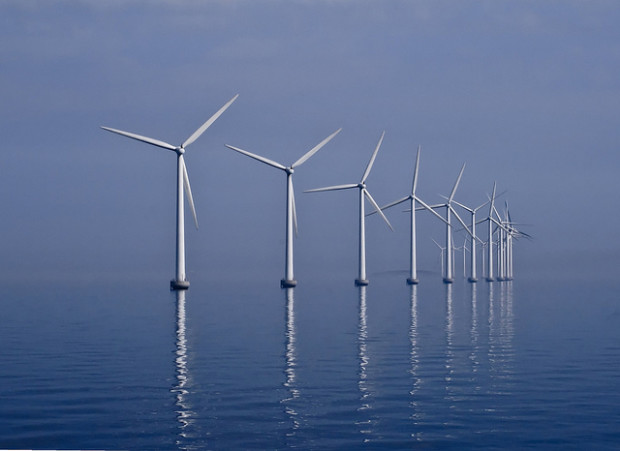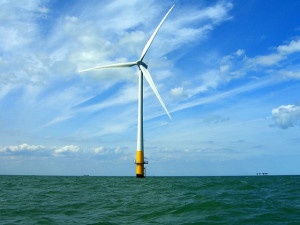We have much more to do and your continued support is needed now more than ever.
America Must Lean into the Wind on Clean Energy
This week, the Washington Post called America’s pursuit of offshore wind energy a “tortured process” mired in uncertainty and challenges. While that is one way to describe it, National Wildlife Federation has a very different view of the prospects for offshore wind in America and the importance of overcoming the current challenges facing this critical new clean energy source.
For more than 20 years, Europe has been producing clean energy – and tens of thousands of jobs – from its offshore wind resources. Just last year, nearly 300 turbines were installed in order to bring their current offshore wind generation up to just under 5,000 MW. Here in America, we have an immense offshore wind resource sitting right off our shores, yet as the article points out we are still struggling to get our first turbines into the water.

Let’s put this into perspective
America needs real, sustained leadership at both the state and federal levels to advance large-scale clean energy sources in this country if we are to protect current and future generations from the dangers of climate change. NWF’s recent report, Wildlife in a Warming World: Confronting the Climate Crisis, details the devastating impacts we are already seeing across America from climate change. America’s reliance on high-polluting fossil fuels simply has to change if we are to confront this urgent threat, and our vast offshore wind resource presents a truly compelling alternative.
As President Obama said on Inauguration Day:
“The path towards sustainable energy sources will be long and sometimes difficult. But America cannot resist this transition; we must lead it. We cannot cede to other nations the technology that will power new jobs and new industries—we must claim its promise. That is how we will maintain our economic vitality…”
Appropriately-sited offshore wind power is a viable, reliable and clean source of energy that can move America away from polluting fossil fuels that are warming the planet at unsustainable rates. Atlantic wind power is available in close proximity to our largest population centers, and blows strongest during times of peak demand — offering a massive local energy source that can diversify our energy mix and offer a hedge against the volatility of fossil fuel prices. A robust offshore wind industry in the U.S. promises to be an economic powerhouse — with hundreds of thousands of new jobs in design, manufacturing, construction, and operation. We can no longer afford to ignore this opportunity: offshore wind power can and must be part of America’s energy future.

Fortunately, there is good news
All along the Atlantic coast — from Maine to Georgia — states are taking steps forward in the pursuit of offshore wind energy. Most recently, newly elected North Carolina Gov. Pat McCrory has called for offshore wind development off the coast of North Carolina. After more than a decade of delay, the Cape Wind project in Massachusetts has secured the contracts it needs to cross the finish line, and an exciting demonstration project is moving forward in state waters off of Rhode Island. Both of these projects could potentially commence construction as early as next year.
Additionally, the federal Bureau of Ocean Energy Management is moving the leasing process forward in varying forms off the coasts of 10 states (Maine, Massachusetts, Rhode Island, New York, New Jersey, Delaware, Maryland, Virginia, North Carolina and Georgia). Seven pilot-scale projects just received funding from the Department of Energy, and Congress recently prevented the critical Investment Tax Credit for offshore wind from expiring at the end of 2012.
The potential and interest are there. Now is the time to move beyond these preparatory building blocks and into real action to ensure favorable, predictable markets for clean energy.
Let’s look at the Maryland example, the central focus of the Washington Post article. Governor Martin O’Malley and the leadership of the General Assembly are pushing a bill designed to spur progress in advancing offshore wind energy off Maryland’s coast. The federal government has already identified a formal Wind Energy Area for Maryland, and six companies so far have expressed interest in building projects within it.
And there is broad public support. Business groups in Maryland, as well as environmental and public health organizations, are all actively supporting this offshore wind bill as a key next step in making offshore wind a reality off their shores. A January poll found that a growing number of Marylanders and a strong bipartisan majority, 72 percent, support developing offshore wind power. Maryland residents from all political and geographic subgroups said they would pay $2 more per month on their electricity bills to support offshore wind.
Governor O’Malley’s quote in the article hits the nail on the head:
“If we do nothing, large chunks of Maryland will be underwater in the foreseeable future. There will be drought, there will be famine and human pain, suffering and displacement — that’s the one thing we really do know for sure; 98.99 percent of all scientists agree.”
The time for stalling is over. Climate change has not stalled – quite the opposite. Our reliance on polluting fossil fuels continues. Our state and federal leaders must lean into the wind and take meaningful steps forward to ensure America harnesses our largest untapped clean energy resource.





















